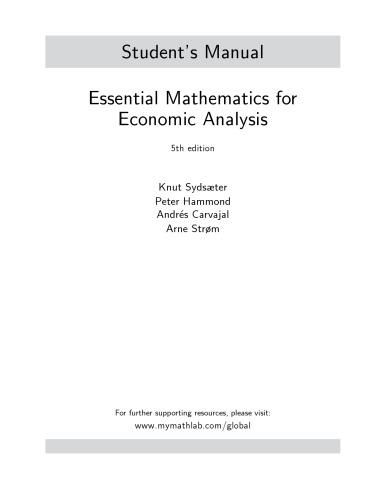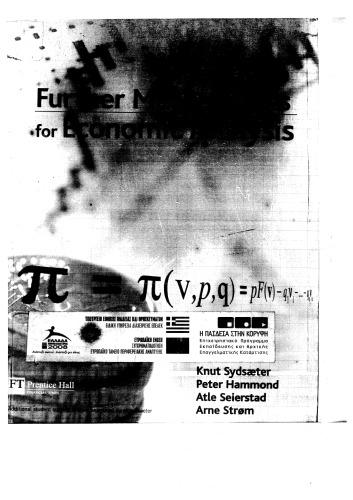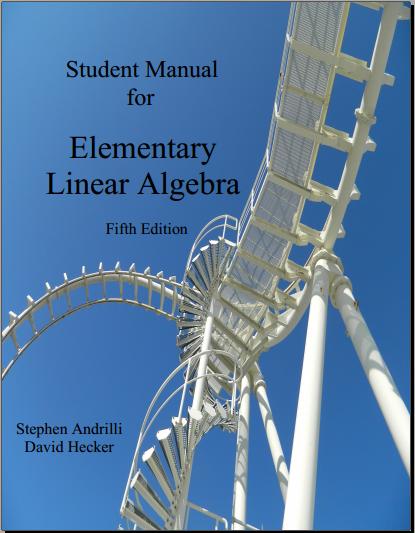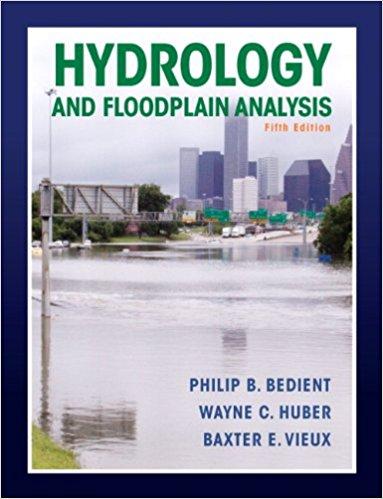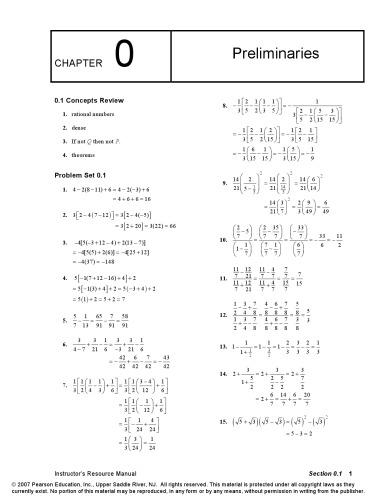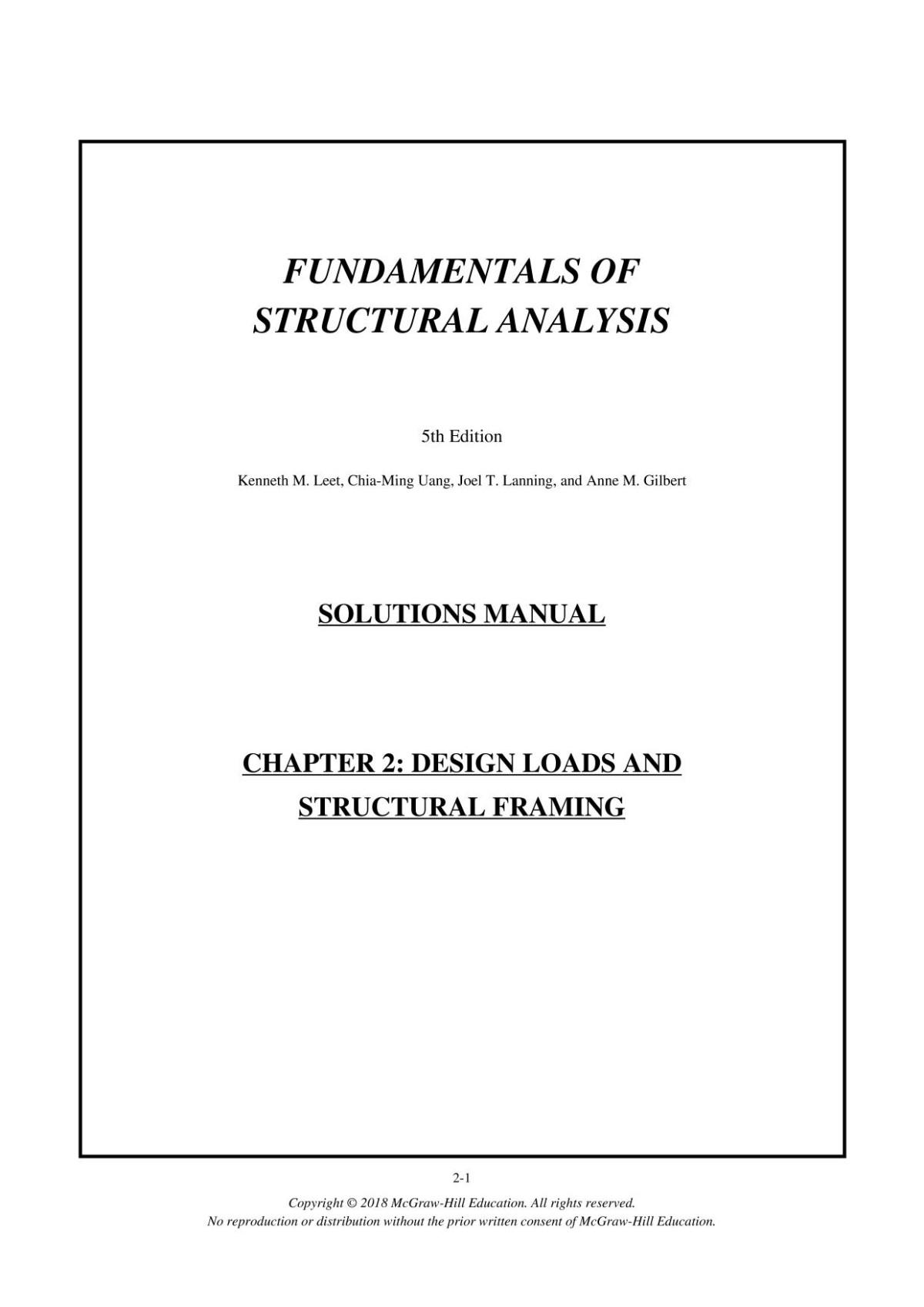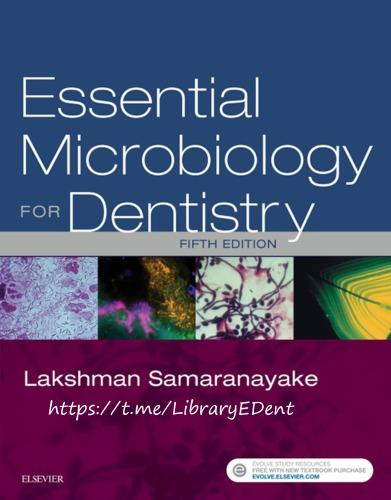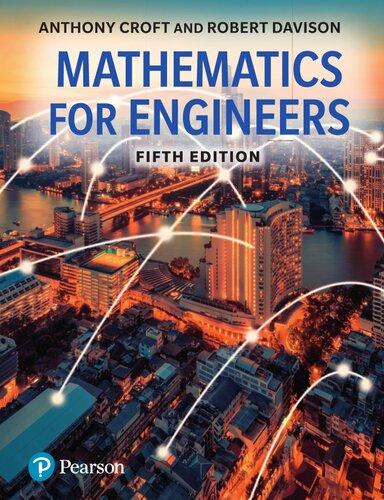2Algebra
2.3Rulesofalgebra 4.(a)(2
2.4Fractions
. (b)Since4x +2=2(2x +1)and4x2 1=(2x +1)(2x 1),thelowestcommondenominator, LCD,is2(2x +1)(2x 1).Then, 6x +25 4x +2
6.(a) 2 x + 1 x +1 3= 2(x +1)+ x 3x
=
=
+
·
3 Alternatively,applythequadraticidentity x 2 + y 2 2xy =(x y)2 with x = a +1and y = a 1toobtain (a +1)2 +(a 1)2 2(a +1)(a 1)=[(a +1) (a 1)]2 =22 =4.
(e)Theexpressionequals
(f)Toclearthefractionswithinboththenumeratoranddenominator,multiplybothby xy toget
(d)Using x
(f)Multiplyingbothnumeratoranddenominatorby x2 1=(x+1)(x 1)yields 10x2 5x(x 1) , whichreducesto 2x x 1 .
2.5Fractionalpowers
5.Theanswersforeachrespectivepartthataregiveninthebookemergeaftermultiplyingboth numeratoranddenominatorbythefollowingterms: (a) √7 √5(b) √5 √3(c) √3+2 (d) x√y y√x (e) √x + h + √x (f)1 √x +1
11.(a)(2x)2 =22x,whichequals2x2 ifandonlyif2x = x2,orifandonlyif x =0or x =2.
(b)Correctbecause ap q = ap/aq
(c)Correctbecause a p =1/ap .
(d)51/x =1/5x =5 x ifandonlyif1/x = x or x2 =1,sothereisnoreal x thatsatisfies theequation.
(e)Put u = ax and v = ay,whichreducestheequationto uv = u + v,or0= uv u v = (u 1)(v 1) 1.Thisistrueonlyforspecialvaluesof u and v andsoforspecialvalues of x and y.Inparticular,theequationisfalsewhen x = y =1.
(f)Putting u = √x and v = √y reducestheequationto2u 2v =2uv,whichholdsifand onlyif uv = u + v,asin(e)above.
2.6Inequalities
3.(a)Thisinequalityhasthesamesolutionsas 3x +1 2x +4 2 > 0, or 3x +1 2(2x +4) 2x +4 > 0, or x 7 2x +4 > 0
Asigndiagramrevealsthattheinequalityissatisfiedfor 7 <x< 2.Aseriouserror istomultiplytheinequalityby2x +4,withoutcheckingthesignof2x +4.If2x +4 < 0, mulitiplyingbythisnumberwillreversetheinequalitysign.4
(b)Theinequalityisequivalentto120/n ≤ 0 75=3/4,or(480 3n)/4n ≤ 0.Asign diagramrevealsthattheinequalityissatisfiedfor n< 0andfor n ≥ 160.5
(c)Thisiseasy: g(g 2) ≤ 0andso0 ≤ g ≤ 2.
(d)Notethat p2 4p +4=(p 2)2,sotheinequalityreducesto (p 2)+3 (p 2)2 = p +1 (p 2)2 ≥ 0.
Thefractionmakesnosenseif p =2.Theconclusionthat p ≥−1and p =2follows.
(e)Theinequalityisequivalentto n 2 n +4 2 > 0 ⇐⇒ n 2 2n 8 n +4
(f) x4 x2 = x2(x2 1) < 0 ⇐⇒ x =0and x2 < 1 ⇐⇒−1 <x< 0or0 <x< 1
6.(a)Itiseasytoseebymeansofasigndiagramthat x(x +3) < 0preciselywhen x liesin theopeninterval( 3, 0).Thereforewehave ⇒ ,butnot ⇐:forexample,if x =10, then x(x +3)=130.
(b) x2 < 9 ⇐⇒−3 <x< 3,so x2 < 9 ⇒ x< 3.If x = 5,forinstance,wehave x< 3 but x2 > 9,hencewecannothave ⇐ here.
(c)If x> 0,then x2 > 0,but x2 > 0alsowhen x< 0.So,wehave ⇐ butnot ⇒. (d)As y2 ≥ 0foranyrealnumber y,wehavethat x> 0whenever x>y2.But x =1 > 0 doesnotimplythat x>y2 for y ≥ 1.Thatis,wehave ⇒ butnot ⇐
4 Itcouldbeinstructivetotesttheinequalityforsomevaluesof x.Forexample,for x =0itisnottrue.What about x = 5?
5 Notethatfor n =0theinequalitymakesnosense.For n =160,wehaveequality.
9.Notethatforany
Notealsothattheinequalityisstrictunless x = y
Toshowthat mA ≥ mG,simplylet x = a and y = b,sothat
0,whichimpliesthat
withstrictinequalitywhenever a = b
Toshowthat mG ≥ mH ,use x =1/a and y =1/b,sothat,from(∗),
Rearranging,wegetthat
where,again,theinequalityisstrictunless a = b.
2.8Summation
3.(a)–(d):Ineachcase,lookatthelastterminthesumandreplace n by k togetanexpression forthe kth term.Callit sk.Thenin(a),(b),and(d)thesumis n k=1 sk,andin(c)wehave n k=0 sk.
(e)Thecoefficientsarethepowers3n for n =1, 2, 3, 4, 5,sothegeneraltermis3nxn
(f)–(g)SeetheanswersintheSolutionsSectionofthebook.
(h)Thisistrickier:onehastoseethateachtermis198largerthanthepreviousterm.6
7.(a)Valid: n k=1 ck2 = c 12 + c 22 + + c n2 = c(12 +22 + + n2)= c n k=1 k2
(b)Wrong,evenfor n =2:theleft-handsideis(a1 + a2)2 = a
2,butthe right-handsideis a2 1 + a2 2,whichisdifferentunless a1a2 =0.
(c)Valid:bothsidesequal b1 + b2 + + bN .
(d)Valid:bothsidesequal51 +52 +53 +54 +55
(e)Valid:bothsidesequal a2 0,j + + a2 n 1,j
(f)Wrong,evenfor n =2:theleft-handsideis a1 + a2/2,buttheright-handsideis (1/k)(a1 + a2).
6 ThisproblemisrelatedtothestoryaboutGaussinSection2.9.
1.(a)Seethesolutioninthebook.
(b)Notefirstthat
or 8000+2025+7488
(c)Because
,wecanuseformulae(2.9.4) and(2.9.5)alongwiththeequality
(d)Usingformulae(2.9.4)and(2.9.5)again,weget
4.¯ a isthemeanofthecolumnmeans¯ aj ,because
Toprove(∗),notethatbecause arj a isindependentofthesummationindex s,itisa commonfactorwhenwesumover
(asj a)for each r.Next,summingover r gives
because m s=1(arj a)isacommonfactorwhenwesumover r.Usingthepropertiesofsums andthedefinitionof¯ aj ,wehave
Similarly,replacing r with s astheindexofsummation,onealsohas
s=1(asj a)= m(¯ aj a).Substitutingthesevaluesinto(∗∗)thenconfirms(∗).
5.(a)(2x)4 =24x4 =16x4 .
(b)2 1 4 1 = 1 2 1 4 = 1 4 ,so(2 1 4 1) 1 =4.
(c)Cancelthecommonfactor4x2yz2 .
(d)Here ( ab3) 3 = ( 1) 3a 3b 9 = a 3b 9 , so[ ( ab3) 3
(e) a5 a3 a 2 a 3 a6 = a6 a3 = a 3 (f) x 2 3 · 8 x 2 3 = x3 8 · 8x 2 3 =(x 5) 3 = x 15
10.Parts(a),(b),(d),(e),and(f)arestraightforward;theirsolutions appearinthebook.For theotherparts:
3+3√2. (g)(1+ x + x2 + x3)(1 x)=(1+ x + x2 + x3) (1+ x + x2 + x3)x =1 x4 (h)(1+ x)4 =(1+ x)2(1+ x)2 =(1+2x + x2)(1+2x + x2),andsoon.
12.Parts(a)and(b)areeasy,sowefocusontheothers:
(c) ax + ay +2x +2y = a(x + y)+2(x + y)=(a +2)(x + y). (d)2x2 5yz+10xz xy =2x2 +10xz (xy+5yz)=2x(x+5z) y(x+5z)=(2x y)(x+5z).
(e) p2 q2 + p q =(p q)(p + q)+(p q)=(p q)(p + q +1).
(f) u3 + v3 u2v v2u = u2(u v)+ v2(v u)=(u2 v2)(u v)=(u + v)(u v)(u v), whichsimplifiesto(u + v)(u v)2 .
16.(a) s 2s 1 s 2s +1 = s(2s +1) s(2s 1) (2s 1)(2s +1) = 2s 4s2 1
(b) x 3 x 1 x x +3 24 x2 9 = x(x +3) (1 x)(x 3) 24 (x 3)(x +3) = 7x 21 (x 3)(x +3) = 7 3 x
(c)Multiplyingbothnumeratoranddenominatorby x2y2 yields y x y2 x2 = y x (y x)(y + x) = 1 x + y
17.(a)Simplycancelthefactor25ab.
(b)Factor x2 y2 =(x + y)(x y),andthencancel x + y
(c)Thefractioncanbewrittenas (2a 3b)2 (2a 3b)(2a +3b) = 2a 3b 2a +3b .
(d) 4x x3 4 4x + x2 = x(4 x2) (2 x)2 = x(2 x)(2+ x) (2 x)2 = x(2+ x) 2 x
25.Leteachsidehavelength s.Thenthearea K oftheequilateraltriangle ABC shownin Fig.SM2.R.25isthesumoftheareasofthethreetriangles ABP , BCP ,and CAP ,which equals 1 2 sh1 + 1 2 sh2 + 1 2 sh3 = K.Itfollowsthat h1 + h2 + h3 =2K/s,whichisindependent ofwhere P isplacedinthetriangle.
7
29.(a)UsingthetrickthatledtoEq.(2.9.4)inthebook, R =3+5+7+ ··· +197+199+201 R =201+199+197+ ··· +7+5+3. Summingverticallytermbyterm,notingthatthereare100terms,gives
2R =204+204+204+ +204+204+204=100 × 204=20400, andthus R =10200.
(b)Hereonehas S =1001+2002+3003+ +8008+9009+10010 =1001(1+2+3+ +8+9+10)=1001 55=55055
3SolvingEquations
3.1Solvingequations
3.(a)Wenotefirstthat x = 3and x = 4bothmaketheequationabsurd.Multiplyingthe equationbythecommondenominator(x+3)(x+4)yields(x 3)(x+4)=(x+3)(x 4), i.e. x2 + x 12= x2 x 12,andthus x =0.
(b)Multiplyingbythecommondenominator(x 3)(x +3)yields3(x +3) 2(x 3)=9, fromwhichweget x = 6.
(c)Multiplyingbythecommondenominator15x,assumingthat x =0,yields18x2 75= 10x2 15x +8x2,fromwhichweget x =5.
5.(a)Multiplyingbythecommondenominator12yields9y 3 4+4y +24=36y,andso y =17/23.
(b)Multiplyingbythecommondenominator2x(x +2)yields8(x +2)+6x =2(2x +2)+7x andso14x +16=11x +4,fromwhichwefindthat3x = 12andso x = 4.
(c)Multiplyingbothnumeratoranddenominatorinthefirstfractionby 1 z leadsto 2 2z z (1 z)(1+ z) = 6 2z +1
Multiplyingeachsideoftheequationby(1 z2)(2z +1)yields(2 3z)(2z +1)=6 6z2 .
Thissimplifiesto2+ z 6z2 =6 6z2 whoseonlysolutionis z =4.
(d)Expandingalltheparenthesesgives
Multiplyingbythecommondenominator24givestheequation6p 9 6+2p 8+8p = 8,whosesolutionis p =15/16.
3.2Equationsandtheirparameters
2.(a)Multiplybothsidesby abx toobtain b + a =2abx.Hence,
(b)Multiplytheequationby cx + d toobtain ax + b = cAx + dA,or(a cA)x = dA b, andthus x =(dA b)/(a cA)providedthat a = cA
(c)Multiplytheequationby x1/2 toobtain 1 2 p = wx1/2.Thus x1/2 = p/2w andso,after squaringeachside, x = p2/4w2
(d)Multiplyeachsideby √1+ x toobtain1+ x + ax =0,so x = 1/(1+ a).
(e) x2 = b2/a2,so x = ±b/a providedthat a =0.
(f)Weseeimmediatelythat x =0.
4.(a) αx a = βx b ifandonlyif(α β)x = a b,so x =(a b)/(α β)providedthat α = β.
(b)Squaringeachsideof √pq =3q +5yields pq =(3q +5)2,so p =(3q +5)2/q provided that q =0.
(c) Y =94+0 2[Y (20+0 5Y )]=94+0 2Y 4 0 1Y ,so0 9Y =90,implyingthat Y =100.
(d)Raiseeachsidetothefourthpowertoobtain K 2 r 2w K = Q4,so K 3 =2wQ4/r,and hence K = 2wQ4/r 1/3
(e)Multiplyingthenumeratoranddenominatoroftheleft-handfractionby4K 1/2L3/4 leads to2L/K = r/w,fromwhichweget L = rK/2w
(f)Raiseeachsidetothefourthpowertoobtain 1 16 p4K 1 (r/2w)= r4.Itfollowsthat K = 1 32 p4r 3w 1
3.3Quadraticequations
3.Theseresultsarestraightforwardandcanbefoundinthebook.Toillustratetheprocess, letusconsiderpart(d):First,rewritetheequationas r2 +(√3 √2)r √6=0,andthen
applytheformulatoobtain
5.(a)Seethesolutioninthebook.
(b)Ifthesmallerofthetwonaturalnumbersis n,thenthelargeris n+1,sotherequirement isthat n2 +(n +1)2 =13.Thisreducesto2n2 +2n 12=0,i.e. n2 + n 6=0,with solutions n = 3and n =2,sothetwonumbersare2and3.7
(c)Iftheshortersidehaslength x,thentheothersidehaslength x +14.Accordingto Pythagoras’sTheoremonehas x2 +(x +14)2 =342,or x2 +14x 480=0.Theonly positivesolutionis x =16,andthen x +14=30.
(d)Iftheusualdrivingspeedis s km/handtheusualtimespentis t hours,then st =80. Since16minutesis16/60=4/15hours,drivingatthespeed s +10km/hfor s 4/15 hoursgives(s +10)(t 4/15)=80.Fromthefirstequation, t =80/s.Insertingthis intothesecondequation,weget(s +10)(80/s 4/15)=80.Rearranging,weobtain s2 +10s 3000=0,whoseonlypositivesolutionis s =50.Sohisusualdrivingspeed is50km/h.
3.4Nonlinearequations
2.(a)Thenumerator5+ x2 isnever0,sotherearenosolutions.
(b)Theequationisobviouslyequivalentto x2 +1+2x x2 +1 =0,or (x +1)2 x2 +1 =0,so x = 1.
(c)Because x = 1isclearlynotasolution,wecanmultiplytheequationby(x +1)2/3 to obtaintheequivalentequation(x +1)1/3 1 3 x(x +1) 2/3 =0.Multiplyingthisequation againby(x +1)2/3 yields x +1 1 3 x =0,whosesolutionis x = 3/2.
(d)Multiplyingby x 1yields x +2x(x 1)=0,or x(2x 1)=0.Hence x =0or x =1/2.
3.(a) z =0satisfiestheequation.If z =0,then z a = za + zb,or(1 a b)z = a.If a + b =1wehaveacontradiction.If a + b =1,then z = a/(1 a b).
(b)Theequationisequivalentto(1+ λ)µ(x y)=0,so λ = 1, µ =0,or x = y.
(c) µ = ±1makestheequationmeaningless.Otherwise,multiplyingtheequationby1 µ2 yields λ(1 µ)= λ,or λ(2 µ)=0,so λ =0or µ =2.
(d)Theequationisequivalentto b(1+ λ)(a 2)=0,so b =0, λ = 1,or a =2.
7 Ifwehadaskedfor integer solutions,wewouldhave 3and 2inaddition.
3.5Usingimplicationarrows
3.(a)If
√x 4= √x +5 9, (i) thensquaringeachsidegives x 4=(√x +5 9)2 . (ii)
Expandingthesquareontheright-handsideof(ii)gives x 4= x +5 18√x +5+81, whichreducesto18√x +5=90or √x +5=5,implyingthat x +5=25andso x =20. Thishowsthat if x isasolutionof(i),then x =20.Noothervalueof x cansatisfy(i). Butifwecheckthissolution,wefindthatwith x =20theleft-handsideof(i)becomes √16=4,andtheright-handsidebecomes √25 9=5 9= 4.Thismeansthat equation(i)actuallyhasnosolutionsatall.8
(b)If x isasolutionof
√x 4=9 √x +5, (iii) thenjustasinpart(a)wefindthat x mustbeasolutionof x 4=(9 √x +5)2 . (iv)
Now,(9 √x +5)2 =(√x +5 9)2,soequation(iv)isequivalenttoequation(ii)in part(a).Thismeansthat(iv)hasexactlyonesolution,namely x =20.Insertingthis valueof x intoequation(iii),wefindthat x =20 is asolutionof(iii).
AgeometricexplanationoftheresultscanbegivenwithreferencetoFig.SM3.5.3.Wesee thatthetwosolidcurvesinthefigurehavenopointincommon,thatis, theexpressions √x 4and √x +5 9arenotequalforanyvalueof x. 9 Thisexplainswhytheequation in(a)hasnosolution.Thedashedcurve y =9 √x +5,ontheotherhand,intersects y = √x +5for x =20(andonlythere),andthiscorrespondstothesolutioninpart(b).10
8 Butnotethat42 =( 4)2,i.e.thesquareoftheleft-handsideequalsthesquareoftheright-handside.Thatis howthespurioussolution x =20managedtosneakin.
9 Infact, √x 4 (√x +5 9)increaseswith x,sothereisnopointofintersectionfarthertotheright,either.
10 Inpart(a)itwasnecessarytochecktheresult,becausethetransitionfrom(i)to(ii)isonlyanimplication, notanequivalence.Similarly,itwasnecessarytochecktheresultinpart(b),sincethetransitionfrom(iii)to(iv) alsoisonlyanimplication—atleast,itisnotclearthatitisanequivalence.(Afterwards,itturnedouttobean equivalence,butwecouldnotknowthatuntilwehadsolvedtheequation.)
FigureSM3.5.3
3.6Twolinearequationsintwounknowns
4.(a)Ifthetwonumbersare x and y,then x + y =52and x y =26.Addingthetwo equationsgives2x =78,so x =39,andthen y =52 39=13.
(b)Letthecostofonetablebe$x andthecostofonechair$y.Then5x +20y =1800and 2x +3y =420.Solvingthissystemyields x =120, y =60.
(c)Let x and y bethenumberofunitsproducedofBandP,respectively.Thisgivesthe equations x = 3 2 y and200x +300y =180000.Insertingtheexpressionfor x fromthe firstequationintothesecondequationgives300y +300y =180000,whichyieldsthe solution y =300andthen x =450.Thus,450unitsofqualityAand300unitsofquality Bshouldbeproduced.
(d)Supposethatthepersoninvested$x at5%and$y at7.2%.Then x + y =10000and 0.05x +0.072y =676.Thesolutionis x =2000and y =8000.
ReviewexercisesforChapter3
2.(a)Assuming x = ±4,multiplyingbythelowestcommondenominator(x 4)(x+4)reduces theequationto(x 3)(x +4)=(x +3)(x 4)or x = x,so x =0.
(b)Thegivenequationmakessenseonlyif x = ±3.Ifwemultiplytheequationbythe commondenominator(x+3)(x 3)weget3(x+3)2 2(x2 9)=9x+27or x2+9x+18=0, withthesolutions x = 6and x = 3.Theonlysolutionofthegivenequationis therefore x = 6.
(c)Subtracting2x/3fromeachsidesimplifiestheequationto0= 1+5/x,whoseonly solutionis x =5.
(d)Assuming x =0and x = ±5,multiplybythecommondenominator x(x 5)(x +5)to get x(x 5)2 x(x2 25)= x2 25 (11x +20)(x +5).Expandingeachsideofthis equationgives x3 10x2 +25x x3 +25x = x2 25 11x2 75x 100,whichsimplifies to50x = 125 75x withsolution x = 1.
4.(a)Multiplyeachsideoftheequationby5K 1/2 toobtain15L1/3 = K 1/2.Squaringeach sidegives K =225L2/3
(b)Raiseeachsidetothepower1/t toobtain1+ r/100=21/t,andso r =100(21/t 1).
(c) abxb 1 0 = p,so x b 1 0 = p/ab.Nowraiseeachsidetothepower1/(b 1).
(d)Raiseeachsidetothepower ρ toget(1 λ)a ρ + λb ρ = c ρ,or b ρ = λ 1[c ρ (1 λ)a ρ].Nowraiseeachsidetothepower 1/ρ
4FunctionsofOneVariable
4.2Basicdefinitions
1.(a) f (0)=02 +1=1, f ( 1)=( 1)2 +1=2, f (1/2)=(1/2)2 +1=1/4+1=5/4,and f (√2)=(√2)2 +1=2+1=3.
(b)(i)Since( x)2 = x2 , f (x)= f ( x)forall x.(ii) f (x+1)=(x+1)2 +1= x2 +2x+1+1= x2 +2x +2and f (x)+ f (1)= x2 +1+2= x2 +3.Thusequalityholdsifandonlyif x2 +2x +2= x2 +3,i.e.ifandonlyif x =1/2.(iii) f (2x)=(2x)2 +1=4x2 +1and 2f (x)=2x2 +2.Now,4x2 +1=2x2 +2 ⇐⇒ x2 =1/2 ⇐⇒ x = ± 1/2= ± 1 2 √2.
13.(a)Werequire5 x ≥ 0,so x ≤ 5.
(b)Thedenominator x2 x = x(x 1)mustbedifferentfrom0,so x =0and x =1.
(c)Tobeginwith,thedenominatormustbenonzero,sowerequire x =2and x = 3. Moreover,sincewecanonlytakethesquarerootofanonnegativenumber, thefraction (x 1)/(x 2)(x +3)mustbe ≥ 0.Asigndiagramrevealsthat Df =( 3, 1] ∪ (2, ∞).
Noteinparticularthatthefunctionisdefinedwithvalue0at x =1.
4.4Linearfunctions
10.Thepointsthatsatisfytheinequality3x +4y ≤ 12arethosethatlieonorbelowthestraight line3x +4y =12,asexplainedinExample4.4.6forasimilarinequality.Thepointsthat satisfytheinequality x y ≤ 1,orequivalently, y ≥ x 1,arethoseonorabovethestraight line x y =1.Finally,thepointsthatsatisfytheinequality3x + y ≥ 3,orequivalently, y ≥ 3 3x,arethoseonorabovethestraightline3x+y =3.Thesetofpointsthatsatisfyall thesethreeinequalitiessimultaneouslyistheshadedsetshown inFig.A4.4.10inthebook.
4.6Quadraticfunctions
9.Thekeytotheargumentispart(b).Wefindthat f (x)= Ax2 + Bx + C,withcoefficients
A = a2 1 +a2 2 + +a2 n, B =2(a1b1 +a2b2 + +anbn),and C = b2 1 +b2 2 + +b2 n.Now,incase B2 4AC> 0,thenaccordingtoformula(2.3.4),theequation f (x)= Ax2 +Bx+C =0would havetwodistinctsolutions.Thiswouldcontradict f (x) ≥ 0forall x.Hence B2 4AC ≤ 0 andtheconclusionfollows.
4.7Polynomials
3.(a)Theansweris2x2 +2x +4+ 3 x 1 , because (2x 3 +2x 1) ÷ (x 1)=2x 2 +2x +4 2
(b)Theansweris x2 +1,because
(c)Theansweris
(d)Theansweris
, because
4.(a)Sincethegraphintersectsthe x-axisatthetwopoints x = 1and x =3,wetrythe quadraticfunction f (x)= a(x +1)(x 3),forsomeconstant a> 0.Butthegraph passesthroughthepoint(1, 2),soweneed f (1)= 2.Since f (1)= 4a forourchosen function, a = 1 2 .Thisleadstotheformula y = 1 2 (x +1)(x 3).
(b)Becausetheequation f (x)=0musthaveroots x = 3, 1, 2,wetrythecubicfunction f (x)= b(x +3)(x 1)(x 2).Then f (0)=6b.Accordingtothegraph, f (0)= 12.So b = 2,andhence y = 2(x +3)(x 1)(x 2).
(c)Herewetryacubicpolynomialoftheform y = c(x +3)(x 2)2,with x =2asadouble root.Then f (0)=12c.Fromthegraphweseethat f (0)=6,andso c = 1 2 .Thisleads totheformula y = 1 2 (x +3)(x 2)2 .
8.Polynomialdivisiongives
4.8Powerfunctions
4.(a)C.Thegraphisaparabolaandsincethecoefficientinfrontof x2 ispositive,ithasa minimumpoint.
(b)D.Thefunctionisdefinedfor x ≤ 2andcrossesthe y-axisat y =2√2 ≈ 2 8.
(c)E.Thegraphisaparabolaandsincethecoefficientinfrontof x2 isnegative,ithasa maximumpoint.
(d)B.When x increases, y decreases,and y becomescloseto 2when x islarge.
(e)A.Thefunctionisdefinedfor x ≥ 2andincreasesas x increases.
(f)F.Let y =2 ( 1 2 )x.Then y increasesas x increases.Forlargevaluesof x,onehas y closeto2.
4.10Logarithmicfunctions
3.(a)3x4x+2 =8when3x4x42 =8or(12)x42 =8,andso12x =1/2.Takingthenaturallog ofeachsidegives x ln12= ln2,so x = ln2/ ln12.
(b)Sinceln x2 =2ln x,theequationreducesto7ln x =6,soln x =6/7,andthus x = e6/7 .
(c)Onepossiblewaytosolvetheequationistorewriteitas4x(1 4 1)=3x(3 1),or 4x (3/4)=3x 2,so(4/3)x =8/3,implyingthat x =ln(8/3)/ ln(4/3).Alternatively, startbydividingbothsidesby3x toobtain(4/3)x(1 1/4)=3 1=2,so(4/3)x =8/3 asbefore.
Forparts(d)–(f)below,weusethedefinition aloga x = x forall a,x> 0.
(d)log2 x =2impliesthat2log2 x =22 or x =4.
(e)logx e2 =2impliesthat xlogx e2 = x2 or e2 = x2.Hence x = e
(f)log3 x = 3impliesthat3log3 x =3 3 or x =1/27.
4.Directly,theequation Aert = Best impliesthat ert/est = B/A,so e(r s)t = B/A.Takingthe lnofeachsidegives(r s)t =ln(B/A),so t = 1 r s ln B A .Alternatively,applylntoeach sideoftheoriginalequation,leadingtoln A + rt =ln B + st.Thisgivesthesamesolution.
5.Let t denotethenumberofyearsafter1990.Assumingcontinuousexponentialgrowth,when the GDP ofthetwonationsisthesame,onemusthave1.2 · 1012 · e0 09t =5.6 · 1012 · e0 02t . Applyingtheanswerfoundinpart(a),weobtain
Accordingtothis,thetwocountrieswouldhavethesame GDP approximately22yearsafter 1990,soin2012.
ReviewexercisesforChapter4
14.(a) p(x)= x(x2 + x 12)= x(x 3)(x +4),because x2 + x 12=0for x =3and x = 4. (b) ±1, ±2, ±4, ±8aretheonlypossibleintegerzeros.Bytrialanderrorwefindthat q(2)= q( 4)=0,so2(x 2)(x +4)=2x2 +4x 16isafactorfor q(x).Bypolynomial divisionwefindthat q(x) ÷ (2x2 +4x 16)= x 1/2,so q(x)=2(x 2)(x +4)(x 1/2).
17.Checkbydirectcalculationthat p(2)= 1 4 23 22 11 4 2+ 15 2 =2 4 11 2 + 15 2 =0,so x 2 mustbeafactorof p(x).Bydirectdivision,wefindthat p(x) ÷ (x 2)= 1 4 (x2 2x 15), whichfactorsas 1 4 (x +3)(x 5),so x = 3and x =5arethetwootherzeros.(Alternatively, p(x)hasthesamezerosas q(x)=4p(x)= x3 4x2 11x +30.Anyintegerzeroof q(x)must beafactorof30,sotheonlypossibilitiesare ±1, ±2, ±3, ±5, ±10, ±15,and ±30.Butitis tedioustocheckall14possiblevaluesof x inordertofindthezerosinthisway,anditdoes notfindanynonintegerroots.)
19.Fortheleft-handgraph,notethatfor x =0,onehas y = f (x)= a + b/x 1+ c/x ,sothat y tends to a as x becomeslargepositiveornegative.Thegraphshowsthat a> 0.Thereisabreak pointat x = c,and c> 0,so c< 0.Also f (0)= b/c> 0,so b< 0.Theright-handgraph ofthequadraticfunction g isaparabolawhichisconvex,so p> 0.Moreover r = g(0) < 0. Finally, g(x)hasitsminimumat x = x∗ = q/2p.Since x∗ > 0and p> 0,weconcludethat q< 0.
23.(a)ln(x/e2)=ln x ln e2 =ln x 2for x> 0.
(b)ln(xz/y)=ln(xz) ln y =ln x +ln z ln y for x,y,z> 0
(c)ln(e3x2)=ln e3 +ln x2 =3+2ln x for x> 0.(Ingeneral,ln x2 =2ln |x|.)
(d)When x> 0,notethatln(1/x)= ln x andso
1 2 ln x 3 2 ln(1/x) ln(x +1)=2ln x ln(x +1)=ln x 2 ln(x +1)=ln[x 2/(x +1)]
5PropertiesofFunctions
5.3Inversefunctions
4.(a)Thefunction f doeshaveaninversesinceitisone-to-one.Thisisshowninthetableby thefactthatallthenumbersinthesecondrow,thedomainof f 1,aredifferent.The inverseassignstoeachnumberinthesecondrow,thecorresponding numberinthefirst row.Inparticular, f 1(2)= 1.
(b)Since f (x)increasesby2foreachunitincreasein x,onehas f (x)=2x + a forasuitable constant a.Butthen a = f (0)=4,so f (x)=2x +4.Solving y =2x +4for x yields x = 1 2 y 2,sointerchanging x and y gives y = f 1(x)= 1 2 x 2.
9.(a)(x3 1)1/3 = y ⇐⇒ x3 1= y3 ⇐⇒ x =(y3 +1)1/3.Ifweuse x astheindependent variable, f 1(x)=(x3 +1)1/3 R isthedomainandrangeforboth f and f 1
(b)Thedomainconsistsofall x =2.Forallsuch x onehas x +1 x 2 = y ⇐⇒ x +1= y(x 2) ⇐⇒ (1 y)x = 2y 1 ⇐⇒ x = 2y 1 1 y = 2y +1 y 1
Using x astheindependentvariable, f 1(x)=(2x +1)/(x 1).Thedomainofthe inverseisall x =1.
(c)Hereonehas y =(1 x3)1/5 +2 ⇐⇒ y 2=(1 x3)1/5 ⇐⇒ (y 2)5 =1 x3 ⇐⇒ x3 =1 (y 2)5 , whichisequivalentto x =[1 (y 2)5]1/3.With x asthefreevariable, f 1(x)=[1 (x 2)5]1/3.Forboth f and f 1,thewholeoftherealline R isboththe domainandtherange.
10.(a)Thedomainis R andtherangeis(0, ∞),sotheinverseisdefinedon(0, ∞).From y = ex+4 onehasln y = x +4,so x =ln y 4, y> 0.
(b)Therangeis R,whichisthedomainoftheinverse.From y =ln x 4,onehasln x = y+4, andso x = ey+4
(c)Thedomainis R.Onthisdomainthefunctionisincreasing,with y → ln2as x →−∞ and y →∞ as x →∞.Sotherangeofthefunctionis(ln2, ∞).From y =ln 2+ ex 3 onehas ey =2+ ex 3,so ex 3 = ey 2.Hence, x =3+ln(ey 2)for y> ln2.
5.4Graphsofequations
1.(a)Thecurveintersectstheaxes x =0and y =0atthepoints(0, ±√3)and(±√6, 0)respectively.Itisalsoentirelyboundedbytherectanglewhosefourcornersare(±√6, ±√3). Moreover,itissymmetricaboutbothaxes,sinceallitspointstaketheform(±√ξ, ±√η), where ξ,η areanypairofpositiverealnumberssatisfying ξ2 +2η2 =6.Putting x = y yieldsthefourpoints(±√2, ±√2)onthecurve.Morepointscanbefoundbyfixingany x satisfying 6 <x< 6,thensolvingfor y 11
(b)Thesameargumentasin(a)showsthatthecurveintersectsonlytheaxis x =0,at (0, ±1).Therearenopointsonthegraphwhere y2 < 1.Asin(a),itissymmetricabout
11 Thecurveiscalledanellipse.Seethenextsection.
bothaxes.Itcomesintwoseparateparts:below y = 1;above y =1.Putting x2 =1 andthen x2 =9yieldstheadditionalpoints(±1, ±√2)and(±3, ±√10).12
5.5Distanceintheplane
8.Themethodofcompletingthesquareusedinproblem5showsthat
Providedthat A2 + B2 > 4C,thelastequationisthatofacirclecentredat( 1 2 A, 1 2 B)with radius 1 2 √A2 + B2 4C.If A2 + B2 =4C,thegraphconsistsonlyofthepoint( 1 2 A, 1 2 B). For A2 + B2 < 4C,thesolutionsetisempty.
5.6Generalfunctions
1.Ineachcase,except(c),theruledefinesafunctionbecauseitassociateswitheachmember oftheoriginalsetauniquememberinthetargetset.Forinstance,in(d),ifthevolume V ofasphereisgiven,theformula V = 4 3 πr3 intheappendiximpliesthattheradiusis r =(3V/4π)1/3.Butthentheformula S =4πr2 intheappendixgivesthesurfacearea. Substitutingfor r inthisformulagives S =4π(3V/4π)2/3 =(36π)1/3V 3/2 thatexpressesthe surfaceareaofasphereasafunctionofitsvolume.
ReviewexercisesforChapter5
7.(a)Thefunction f isdefinedandstrictlyincreasingfor ex > 2,i.e. x> ln2.Itsrangeis R because f (x) →−∞ as x → ln2+,and f (x) →∞ as x →∞.From y =3+ln(ex 2), wegetln(ex 2)= y 3,andso ex 2= ey 3,or ex =2+ ey 3,so x =ln(2+ ey 3). Hence f 1(x)=ln(2+ ex 3), x ∈ R.
(b)Notethat f isstrictlyincreasing.Moreover, e λx →∞ as x →−∞,and e λx → 0as x →∞.Therefore, f (x) → 0as x →−∞,and f (x) → 1as x →∞.Sotherangeof f , andthereforethedomainof f 1,is(0, 1).Because y = a e λx + a weget e λx + a = a/y, so e λx = a(1/y 1),or λx =ln a+ln(1/y 1).Thus x = (1/λ)ln a (1/λ)ln(1/y 1), andthereforetheinverseis f 1(x)= (1/λ)ln a (1/λ)ln(1/x 1),with x ∈ (0, 1).
6Differentiation
6.2Tangentsandderivatives
6.Forparts(a)–(c)wesetouttheexplicitstepsoftherecipeingiven inthebook;forparts (d)–(f)westillfollowtherecipe,butexpressthestepsmoreconcisely.
12 Thegraphisahyperbola.Seethenextsection.
(a)(A) f (a + h)= f (0+ h)=3h +2;(B) f (a + h) f (a)= f (h) f (0)=3h +2 2=3h; (C)–(D)[f (h) f (0)]/h =3;(E)[f (h) f (0)]/h =3 → 3as h → 0,so f ′(0)=3.The slopeofthetangentat(0, 2)is3.
(b)(A) f (a + h)= f (1+ h)=(1+ h)2 1=1+2h + h2 1=2h + h2; (B) f (1+ h) f (1)=2h + h2;(C)–(D)[f (1+ h) f (1)]/h =2+ h; (E)[f (1+ h) f (1)]/h =2+ h → 2as h → 0,so f ′(1)=2.
(c)(A) f (3+ h)=2+3/(3+ h);(B) f (3+ h) f (3)=2+3/(3+ h) 3= h/(3+ h); (C)–(D)[f (3+ h) f (3)]/h = 1/(3+ h); (E)[f (3+ h) f (3)]/h = 1/(3+ h) →−1/3as h → 0,so f ′(3)= 1/3.
(d)[f (h) f (0)]/h =(h3 2h)/h = h2 2 →−2as h → 0,so f ′(0)= 2.
(e) 1 h [f ( 1+ h) f ( 1)]= 1 h 1+ h + 1 1+ h +2 ,whichsimplifiesto h2 1+1 h(h 1) = h h 1 .Thistendsto0as h → 0,so f ′(0)=0.
(f) 1 h [f (1+h) f (1)]= 1 h [(1+h)4 1]= 1 h [(h4 +4h3 +6h2 +4h+1) 1]= h3 +4h2 +6
→ 4 as h → 0,so f ′(1)=4.
9.(a)Applyingtheformula(a b)(a + b)= a2 b2 with a = √x + h and b = √x gives (√x + h √x)(√x + h + √x)=(x + h) x = h
(b)Bydirectcomputation,
(c)Frompart(b),as h → 0onehas f (x + h) f (x) h → 1 2√x = 1 2
6.5Adashoflimits
5.(a)
(b)When x → 0,then(x2 1)/x2 =1 1/x2 →−∞ as x →
(c) 32t 96 t2 2t 3 = 32(t 3) (t 3)(t +1) = 32 t +1
6.(a) f (x) f (1) x 1 = x2 +2x 3 x 1 = (x 1)(x +3) x 1 = x +3 → 4as x → 1 (b) f (x) f (1) x 1 = x +3 → 5as x → 2.
(c) f (2+ h) f (2) h = (2+ h)2 +2(2+ h) 8 h = h2 +6h h = h +6 → 6as h → 0.
(d) f (x) f (a) x a = x2 +2x a2 2a x a = x2 a2 +2(x a) x a = (x a)(x + a)+2(x a) x a ,
whichequals x + a +2andtendsto2a +2as x → a
(e)Sameansweraspart(d),putting x a = h.
(f) f (a + h) f (a h) h = (a + h)2 +2a +2h (a h)2 2a +2h h =4a +4,whichtendsto 4a +4asalimitas h → 0.
6.7Sums,productsandquotients
3.(a) y = 1 x6 = x 6 ⇒ y′ = 6x 7,usingthepowerrule(6.6.4).
(b) y = x 1(x2 +1)√x = x 1x2x1/2 + x 1x1/2 = x3/2 +
(c) y = x 3/2 ⇒ y′ = 3 2 x 5/2 .
(d) y = x +1 x 1 ⇒ y ′ = 1 (x 1) (x +1) 1 (x 1)2 = 2 (x 1)2
(e) y = x x5 + 1 x5 = x 4 + x 5 ⇒ y ′ = 4 x5 5 x6 (f) y = 3x 5 2x +8 ⇒ y ′ = 3(2x +8) 2(3x 5) (2x +8)2 = 34 (2x +8)2
(g) y =3x 11 ⇒ y′ = 33x 12 .
(h) y = 3x 1 x2 + x +1 ⇒ y ′ = 3(x2 + x +1) (3x 1)(2x +1) (x2 + x +1)2 = 3x2 +2x +4 (x2 + x +1)2
6.(a) y′ =6x 12=6(x 2) ≥ 0 ⇐⇒ x ≥ 2,so y isincreasingin[2, ∞).
(b) y′ = x3 3x = x(x2 3)= x(x √3)(x + √3),so,usingasigndiagram,oneseesthat y isincreasingin[ √3, 0]andin √3, ∞
(c) y isincreasingin[ √2, √2],since y ′ = 2(2+ x2) (2x)(2x) (2+ x2)2 = 2(2 x2) (x2 +2)2 = 2(√2 x)(√2+ x) (x2 +2)2 .
(d) y isincreasingin(−∞,x1]andin[0,x2],since y ′ = (2x 3x2)(x +1) (x2 x3) 2(x +1)2 = 2x3 2x2 +2x 2(x +1)2 = x(x x1)(x x2) (x +1)2 , where x1,2 = 1 2 ± 1 2 √5.
7.(a) y′ = 1 2x = 3when x =1,sotheslopeofthetangentis 3.Since y =1when x =1,thepoint–slopeformulagives y 1= 3(x 1),or y = 3x +4.
(b) y =1 2(x2 +1) 1,so y′ =4x/(x2 +1)2 =1and y =0when x =1.Thetangentis therefore y = x 1.
(c) y = x2 x 2,so y′ =2x +2x 3 =17/4.Also y =15/4when x =2,sothepoint–slope formulagives y 15/4=(17/4)(x 2),or y =(17/4)x 19/4.
(d)Here y ′ = 4x3(x3 +3x2 + x +3) (x4 +1)(3x2 +6x +1) [(x2 +1)(x +3)]2 = 1 9 .Also y = 1 3 when x =0,sothetangentis y = 1 3 1 9 x = (x 3)/9.
9.(a)Bythequotientrule, y = at + b ct + d ⇒ y ′ = a(ct + d) (at + b)c (ct + d)2 = ad bc (ct + d)2
(b) y = tn a√t + b = atn+1/2 + btn ⇒ y′ =(n +1/2)atn 1/2 + nbtn 1 .
(c) y = 1 at2 + bt + c ⇒ y ′ = 0 · (at2 + bt + c) 1 · (2at + b) (at2 + bt + c)2 = 2at b (at2 + bt + c)2 .
6.8Thechainrule
3.(a)Write y = 1 (x2 + x +1)5 =(x 2 + x +1) 5 = u 5 , where u = x2 + x +1.Thechainrule gives y′ =( 5)u 6u′ = 5(2x +1)(x2 + x +1) 6 (b)With u = x + x + √x, y = √u = u1/2,so y′ = 1 2 u 1/2u′.Now, u = x + v1/2,with v = x + x1/2.Then u′ =1+ 1 2 v 1/2v′,where v′ =1+ 1 2 x 1/2.Thus,intheend,
(c)Seetheanswerinthebook.
6.10Exponentialfunctions
4.(a) y′ =3x2 +2e2x isobviouslypositiveeverywhere,so y isincreasingin(−∞, ∞).
(b) y′ =10xe 4x +5x2( 4)e 4x =10x(1 2x)e 4x.Asigndiagramshowsthat y isincreasing in[0, 1/2].
(c) y′ =2xe x2 + x2( 2x)e x2 =2x(1 x)(1+ x)e x2 .Asigndiagramshowsthat y is increasingin(−∞, 1]andin[0, 1].
6.11Logarithmicfunctions
3.Formostoftheseproblemsweneedthechainrule.Thatisimportantin itself!Butitimplies inparticularthatif u = f (x)isadifferentiablefunctionof x thatsatisfies f (x) > 0,then d dx ln u = u′ u
(a) y =ln(ln x)=ln u with u =ln x impliesthat y′ = 1 u u ′ = 1 ln x 1 x = 1 x ln x .
(b) y =ln √1 x2 =ln u with u = √1 x2 impliesthat y ′ = 1 u u ′ = 1 √1 x2 2x 2√1 x2 = x 1 x2 Alternatively, √1 x2 =(1 x2)1/2 ⇒ y = 1 2 ln(1 x2),andsoon.
(c) y = ex ln x ⇒ y′ = ex ln x + ex 1 x = ex ln x + 1 x
y =
x
(e) y =ln(ex +1) ⇒ y ′ = ex ex +1
(f) y =ln(x 2 +3x 1) ⇒ y ′ = 2x +3 x2 +3x 1 .
(g) y =2(ex 1) 1 ⇒ y′ = 2ex(ex 1) 2
(h) y = e2x2 x ⇒ y′ =(4x 1)e2x2 x
5.(a)Onemusthave x2 > 1,i.e. x> 1or x< 1.
x
(b)ln(ln x)isdefinedwhenln x isdefinedandpositive,thatis,for x> 1.
(c)Thefraction 1 ln(ln x) 1 isdefinedwhenln(ln x)isdefinedanddifferentfrom1.From (b),ln(ln x)isdefinedwhen x> 1.Further,ln(ln x)=1 ⇐⇒ ln x = e ⇐⇒ x = ee.We concludethat 1 ln(ln x) 1 isdefinedifandonlyif x> 1with x = ee .
6.(a)Thefunctionisdefinedfor4 x2 > 0,thatisin( 2, 2). f ′(x)= 2x/(4 x2) ≥ 0in ( 2, 0],sothisiswhere y isincreasing.
(b)Thefunctionisdefinedfor x> 0. f ′(x)= x2(3ln x+1) ≥ 0forln x ≥−1/3,or x ≥ e 1/3 , soyisincreasingin[e 1/3 , ∞).
(c)Thefunctionisdefinedfor x> 0,and y ′ = 2(1 ln x)( 1/x)2x 2(1 ln x)2 4x2 = (1 ln x)(ln x 3) 2x2
Asigndiagramrevealsthat y isincreasingin x when1 ≤ ln x ≤ 3andsofor x in[e,e3].
9.Intheseproblemswecanuselogarithmicdifferentiation.Alternativelywecanwritethe functionsintheform f (x)= eg(x) andthenusethefactthat f ′(x)= eg(x)g′(x)= f (x)g′(x).
(a)Let f (x)=(2x)x.Thenln f (x)= x ln(2x),so f ′ (x) f (x) =1 ln(2x)+ x 1 2x 2=ln(2x)+1. Hence, f ′(x)= f (x)(ln(2x)+1)=(2x)x(ln x +ln2+1).
(b) f (x)= x√x = eln x √x = e√x ln x,so f ′(x)= e√x ln x · d dx (√x ln x)= x√x ln x 2√x + √x x = x√x 1 2 ( 1 2 ln x +1)
(c)Hereln f (x)= x ln √x = 1 2 x ln x,so f ′(x)/f (x)= 1 2 (ln x +1),whichimpliesthat f ′(x)= 1 2 (√x)x(ln x +1).
11.(a)Seetheanswerinthebook.
(b)Let f (x)=ln(1+ x) 1 2 x.Then f (0)=0andmoreover f ′(x)=1/(x +1) 1 2 = (1 x)/2(x +1).Thisispositivein(0, 1),so f (x) > 0in(0, 1),thusestablishingthe left-handinequality.Toprovetheotherinequality,put g(x)= x ln(1+ x).Then g(0)=0and g′(x)=1 1/(x +1)= x/(x +1) > 0in(0, 1),sotheconclusionfollows.
(c)Let f (x)=2(√x 1) ln x.Then f (1)=0and f ′(x)=(1/√x) 1/x =(√x 1)/x, whichispositivefor x> 1.Theconclusionfollows.
ReviewexercisesforChapter6
15.(a) y′ = 2 x ln x ≥ 0if x ≥ 1.
(b) y ′ = ex e x ex + e x ≥ 0 ⇐⇒ ex ≥ e x ⇐⇒ e 2x ≥ 1 ⇐⇒ x ≥ 0
(c) y ′ =1 3x x2 +2 = (x 1)(x 2) x2 +2 ≥ 0 ⇐⇒ x ≤ 1or x ≥ 2,asasigndiagramwillshow.
7DerivativesinUse
7.1Implicitdifferentiation
3.(a)Implicitdifferentiationw.r.t. x yields(∗)1 y′ +3y +3xy′ =0.Solvingfor y′ yields y′ =(1+3y)/(1 3x).Thedefinitionofthefunctionimpliesthat y =(x 2)/(1 3x).
Substitutingthisintheexpressionfor y′ gives y′ = 5/(1 3x)2.Differentiating(∗) w.r.t. x gives y′′ +3y′ +3y′ +3xy′′ =0.Inserting y′ =(1+3y)/(1 3x)andsolving for y′′ gives y′′ =6y′/(1 3x)= 30/(1 3x)3
(b)Implicitdifferentiationw.r.t. x yields(∗)5y4y′ =6x5,so y′ =6x5/5y4 =(6/5)x1/5
Differentiating(∗)w.r.t. x gives20y3(y′)2 +5y4y′′ =30x4.Inserting y′ =6x5/5y4 and solvingfor y′′ yields y′′ =6x4y 4 4y 1(y′′)2 =6x4y 4 (144/25)x10y 9 =(6/25)x 4/5
8.(a) y + xy′ = g′(x)+3y2y′,andsolvefor y′ .
(b) g′(x + y)(1+ y′)=2x +2yy′,andsolvefor y′ .
(c)First,inordertodifferentiate g(x2y)w.r.t. x,put z = g(u)where u = x2y.Itfollowsthat z′ = g′(u)u′ where u′ =2xy + x2y′.Soonehas2(xy +1)(y + xy′)= g′(x2y)(2xy + x2y′).
Nowsolvefor y′ .
10.(a)Differentiatew.r.t. x whilekeepinginmindthat y dependson x.Thisyieldstheequation 2(x2 + y2)(2x +2yy′)= a2(2x 2yy′).Thensolvefor y′ .
(b)Notethat x =0wouldimplythat y =0.Excludingthispossibility,weseethat y′ =0 when x2 + y2 = a2/2,or y2 = 1 2 a2 x2.Insertingthisintothegivenequationyields x = ± 1 4 a√6andso y = ± 1 2 a√2.Thisyieldsthefourpointsonthegraphatwhichthe tangentishorizontal.
7.2Economicexamples
4.(a)Using(ii)and(iii)tosubstitutefor C and Y respectivelyinequation(i),onehas Y = f (Y )+ I + X g(Y ).
(b)Differentiatingw.r.t. I yields dY/dI = f ′(Y )(dY/dI)+1 g ′(Y )(dY/dI)=(f ′(Y ) g ′(Y ))(dY/dI)+1(∗)
Thus,dY/dI =1/[1 f ′(Y )+ g′(Y )].Importsshouldincreasewhenincomeincreases,so g′(Y ) > 0.ItfollowsthatdY/dI> 0.
(c)Differentiating(∗)w.r.t. I yields,insimplifiednotation,d2Y/dI 2 =(f ′′ g′′)(dY/dI)+ (f ′ g′)(d2Y/dI 2),sod2Y/dI 2 =(f ′′ g′′)(dY/dI)/(1 f ′ +g′)2=(f ′′ g′′)/(1 f ′ +g′)3
7.3Differentiatingtheinverse
5.(a)dy/dx = e x 5,sodx/dy =1/(dy/dx)=1/( e x 5)= ex+5 .
(b)dy/dx = e x/(e x +3),sodx/dy = (e x +3)/e x = 1 3ex
(c)Implicitdifferentiationw.r.t. x yields y3 + x(3y2)(dy/dx) 3x2y x3(dy/dx)=2.Solve fordy/dx,andtheninvert.
7.4Linearapproximations
3.(a) f (0)=1and f ′(x)= (1+ x) 2,so f ′(0)= 1.Then f (x) ≈ f (0)+ f ′(0)x =1 x
(b) f (0)=1and f ′(x)=5(1+ x)4,so f ′(0)=5.Then f (x) ≈ f (0)+ f ′(0)x =1+5x.
(c) f (0)=1and f ′(x)= 1 4 (1 x) 3/4,so f ′(0)= 1 4 .Then f (x) ≈ f (0)+ f ′(0)x =1 1 4 x
8.(a)Wemustdifferentiate3xexy2 .Todoso,firstusetheproductruleinordertoget d dx 3xexy2 =3exy2 +3x d dx exy2 .Thenthechainrulegives d dx exy2 = exy2 (y2 + x2yy′).Overall,therefore,implicitdifferentiationyields3exy2 +3xexy2 (y2 + x2yy′) 2y′ =6x +2yy′ Putting x =1and y =0gives3 2y′ =6,so y′ = 3/2. (b) y(x) ≈ y(1)+ y′(1)(x 1)= 3 2 (x 1)
7.5Polynomialapproximations
2. f ′(x)=(1+ x) 1 , f ′′(x)= (1+ x) 2 , f ′′′(x)=2(1+ x) 3 , f (4)(x)= 6(1+ x) 4 , f (5)(x)=24(1+ x) 5.Then f (0)=0, f ′(0)=1, f ′′(0)= 1, f ′′′(0)=2, f (4)(0)= 6, f (5)(0)=24,andso f (x) ≈ f (0)+ 1 1! f ′(0)x + 1 2! f ′′(0)x + 1 3! f ′′′(0)x 3 + 1 4! f (4)(0)x 4 + 1 5! f (5)(0)x 5 = x 1 2 x 2 + 1 3 x 3 1 4 x 4 + 1 5 x 5
3.With f (x)=5(ln(1+ x) √1+ x)=5ln(1+ x) 5(1+ x)1/2 weget f ′(x)=5(1+ x) 1 5 2 (1+ x) 1/2 and f ′′(x)= 5(1+ x) 2 + 5 4 (1+ x) 3/2
So f (0)= 5, f ′(0)= 5 2 ,and f ′′(0)= 15 4 .Hence,theTaylorpolynomialoforder2about x =0is f (0)+ f ′(0)x + 1 2 f ′′(0)x2 = 5+ 5 2 x 15 8 x2 .
7.6Taylor’sformula
4.(a)WeuseTaylor’sformula(7.6.3)with g(x)=(1+ x)1/3 and n =2.Then g′(x)= 1 3 (1+ x) 2/3 , g′′(x)= 2 9 (1+ x) 5/3,and g′′′(x)= 10 27 (1+ x) 8/3,so g(0)=1, g′(0)= 1 3 , g′′(0)= 2 9 , g′′′(c)= 10 27 (1+ c) 8/3.Itfollowsthat g(x)=1+ 1 3 x 1 9 x2 + R3(x),where R3(x)= 1 6 10 27 (1+ c) 8/3x3 = 5 81 (1+ c) 8/3x3 (b) c ∈ (0,x)and x ≥ 0,so(1+ c) 8/3 ≤ 1,andtheinequalityfollows.
(c)Notethat 3 √1003=10(1+3 10 3)1/3.Usingtheapproximationinpart(a)gives
(1+3 · 10 3)1/3 ≈ 1+ 1 3 3 · 10 3 1 9 (3 · 10 3)2 =1+10 3 10 6 =1 000999
So 3 √1003 ≈ 10 00999.Bypart(b),theerror R3(x)intheapproximation(1+3 10 3)1/3 ≈
1.000999satisfies |R3(x)|≤ 5 81 (3 · 10 3)3 = 5 3 10 9.Hencetheerrorintheapproximation 3 √1003 ≈ 10 00999is10|R3(x)|≤ 50 3 10 9 < 2 10 8,implyingthattheansweriscorrect to7decimalplaces.
7.7Elasticities
9.(a)Elx A = x A dA dx =0.
(b)Elx(fg)= x fg (fg)′ = x fg (f ′ g + fg′)= xf ′ f + xg′ g =Elx f +Elx g
(c)Elx f g = x (f/g) f g ′ = xg f gf ′ fg′ g2 = xf ′ f xg′ g =Elx f Elx g
(d)Seetheanswerinthebook.
(e)Thiscaseislike(d),butwith+g replacedby g,and+g′ by g′
(f) z = f (u)and u = g(x)implythat Elx z = x z dz dx = x u u z dz du du d
7.8Continuity
3.Bythepropertiesofcontinuousfunctionsstatedinthebook,allthe functionsarecontinuous wherevertheyaredefined.So(a)and(d)aredefinedeverywhere.In (b)wemustexclude x =1;in(c)thefunctionisdefinedfor x< 2.Next,in(e)wemustexcludevaluesof x that makethedenominator0.Thesevaluessatisfy x2 +2x 2=0,or(x +1)2 =3,sotheyare x = ±√3 1.Finally,in(f),thefirstfractionrequires x> 0,andthentheotherfractionis alsodefined.
7.9Moreonlimits
2.(a)limx→0+ (x2 +3x 4)=02 +3 · 0 4= 4.
(b) |x| = x for x< 0.Hence,lim x→0 x + |x| x =lim x→0 x x x =lim x→0 0=0.
(c) |x| = x for x> 0.Hence,lim x→0+ x + |x| x =lim x→0+ x + x x =lim x→0+ 2=2.
(d)As x → 0+ onehas √x → 0andso 1/√x →−∞
(e)As x → 3+ onehas x 3 → 0+ andso x/(x 3) →∞. (f)As x → 3 onehas x 3 → 0 ,andso x/(x 3) →−∞
5.(a)Verticalasymptote, x = 1.Moreover, x2 ÷ (x +1)= x 1+1/(x +1),so y = x 1is anasymptoteas x →±∞
